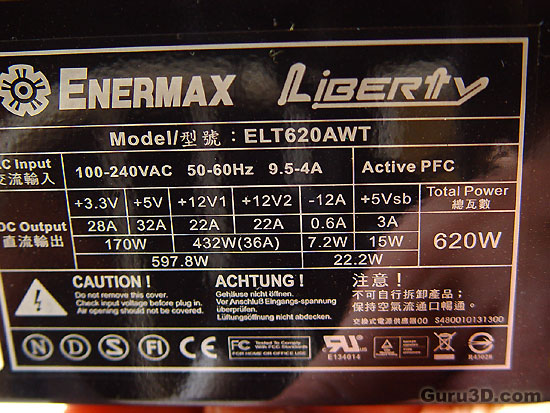Page 2
I've got the power ...
I already tried to make you aware of the importance of power consumption these days. It really is remarkable what a PC consumes (power wise). Manufacturers really need to take a good look at this problem as it is a growing concern. Let's do a little math with an average to high-end PC okay ? Take a Pentium 4 3.6 GHz Prescott based PC armed with the now mid-range Radeon x800 XT PE, three HDs, a DVD-writer and CD Writer. When windows boots it'll use up no more than like 120-130 Watts.
The minute you overclock your processor and graphics card, and use the HDs and optical drives, your wattage will rise to about 350-380 Watts and can, at very stressful points, peak even higher. That still leaves plenty of room to play around. However, for every additional HD or optical drive you need to add 10 Watts and that's where the problem nowadays is.
Do you choose the never ending Guru path of upgrades in the form of
SLI or Crossfire graphics cards ? Add another 75-100 Watts to the margin we just set. Do you have a dual CPU based rig or Dual Core processor ? That'll cost you about an extra 80 Watts and then there is additional cooling to ventilate all these "hot" gadgets. Therefore always choose a PSU with plenty of 'breathing' space for future upgrades and devices.At this time I suggest you get at least a 400 Watt PSU for any mediocre PC, where that number was 300 Watts two years ago. With a lot of HD's and extras like active fans and case-mods such as lights, or if simply powering a high-end gaming rig, go for something even higher than 400 Watt. Starting with a 520 Watt PSU today is not really that bad of a specification for today's high-end computers.
By now I think I have been able to make you aware of the
point I'm trying to make. We need a good PSU these days, and in the near future probably diesel backed up generators in our gardens!Right, let's talk about the Liberty.
Features:
· Full compliance with the highest standard to desktop power requirements
· Split 12V rails provide most stable current to CPU, GPU, MB and drives
· Full support of Dual Core systems (incl. Pentium D EE and Athlon 64 X2) & Dual CPU systems
· Convertible design to power up ATX/BTX systems and support dual CPU entry-level server/workstation
· PF value up to 0.99 to provide stable and clean power under 100-240VAC by auto switching
· High efficiency of about 80% under wide load range (30-100%) minimizes your electricity bill
· Special design 12cm fan combines silence and cooling by intelligent speed control
· Protected by OCP, OVP, UVP, OLP, SCP, and OTP for maximum safety
· Full rated power under 0-40 o C/32-104 o F ambient temperature
· Smarter cable choice and better cable routing for a neat and tidy case
· Unique 4-pin Molex + SATA connectors in pairs give you free choice on using either PATA or SATA devices
· Support of Dual PCI-E graphics cards, SLI or CrossFire
· Toughest EMI shielding protects your system and near-by appliances
What immediately strikes the eye is the fact that there are two 12volts rails, I mean it's fantastic that there are two of them if you decide to do some SLI/Crossfire gaming yet they are 22 Amps each. For example a single GeForce 7800 GTX graphics card can peak towards 20-22 AMPs. DUAL in SLI NVIDIA recommends 30 Amps in total on the 12 volts rails.
Power Factor Correction - PFC
The Enermax PSU we tested was model ELT620AWT, I mention this specifically as this model has a very nice feature called active PFC. To put it in simple terms, Active PFC PSUs are more expensive and from a power consumption point of view more efficient. Power Factor Correction (PFC) allows power distribution to operate at its highest efficiency.
There are two types of PFC, Active PFC and Passive PFC. This PSU has active PFC. Active PFC uses a circuit to correct power factor, Active PFC is able to generate a theoretical power factor of over 95%. Active Power Factor Correction also markedly diminishes total harmonics, automatically corrects for AC input voltage, and is capable of a full range of input voltage. Since Active PFC is the more complex method of Power Factor Correction, it is definitely more expensive to produce an active PFC power supply.
Right, allow me to commence with both the beginning and the end results straight away. Ladies and gentlemen .. it's time to start the the sexy photo shoot.

